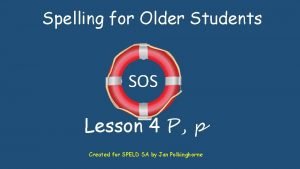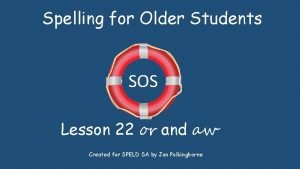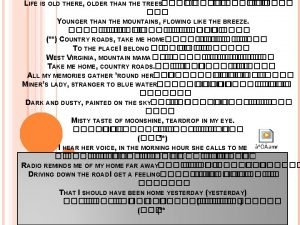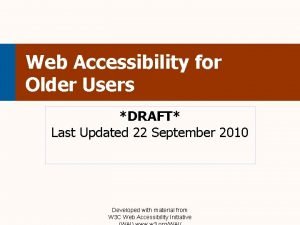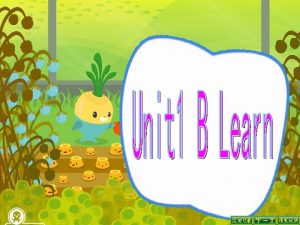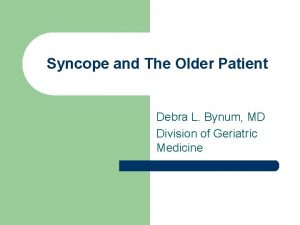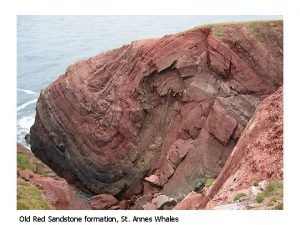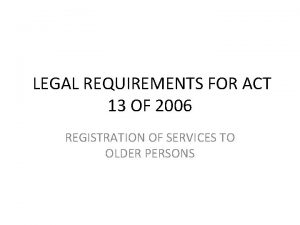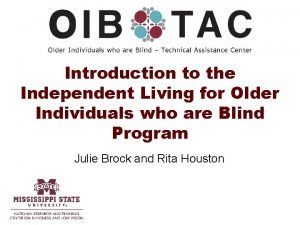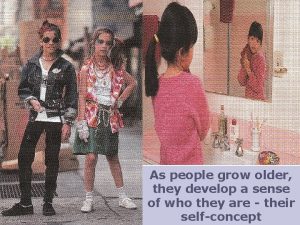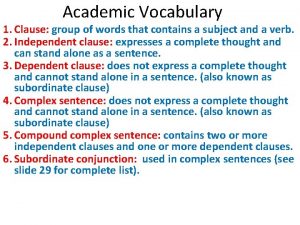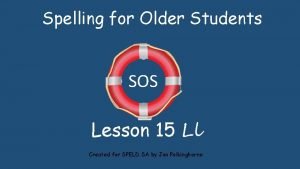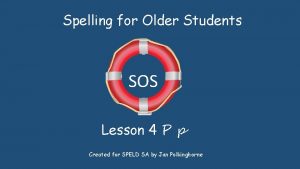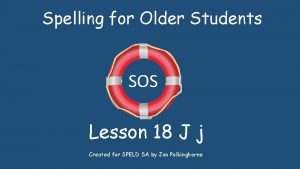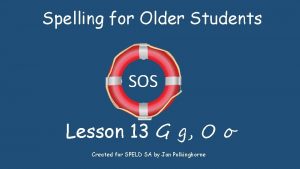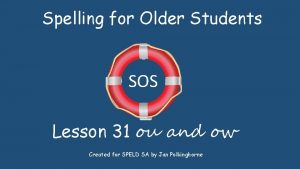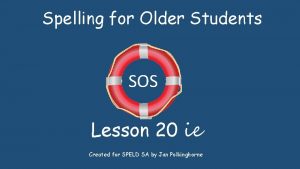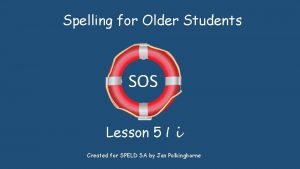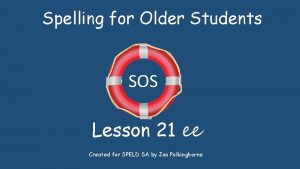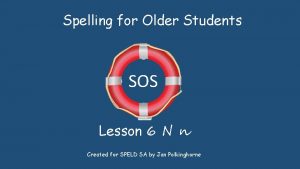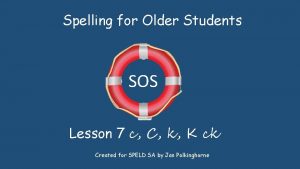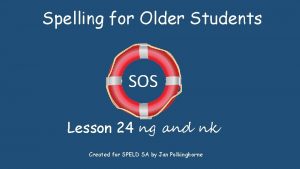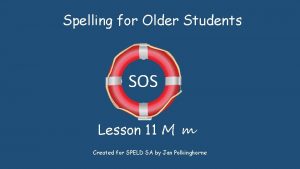Spelling for Older Students SOS Lesson 4 P
















- Slides: 16

Spelling for Older Students SOS Lesson 4 P, p Created for SPELD SA by Jan Polkinghorne

Words in a sentence Take it in turns with a friend. One say a sentence and the other counts words, then swap.

Sounds in a word Say the names of these pictures. Use your fingers to count how many sounds in each word. NOTE that is sounds not letters. b-ee-t-l b-r-i-j Click for answers b-u-n-k

What is the same about all these pictures. Say the words aloud. They all start with the sound p- paint, parrot, pack, Click the box for the answer. pencils, plug, plane, pelican, peas, pear, peck, pips, plan.

vowel or consonant All letters in our alphabet belong to one of two groups p = consonant p is formed when an explosion of air comes out of our mouth as our lips open Put your fingers on your throat. There is little or no movement. Say whether these are vowel or consonant: - s a t i We need to know whether a letter is a vowel or consonant to help us apply spelling rules.

Which pictures begin with ‘p’. 10 paint, parrot, pack, pencils, peck, plane, pelican, pear, plug Click the box for answers.

Sort these pictures into those that start with p and those ending with p. Can you think of others which do to add to your lists? Start p : - pancakes, pig, paid, pineapple, printer, petrol End p: - cap, clap, cup Click the box for answers. Both start and end: - pump

What sounds the same about the pictures in each row? Answers next page. Click to reveal successive rows.

What sounds the same about the pictures in each row? All have ump in them stump, pump , hump, dump. stumps All end with p: cap, clap, cup, lip, tap. All start with p- pack, paint, parrot, pelican, pencil All start and end with m- matches, microphone, meat, man, mouse.

Point to the word your teacher sounds - blend the sounds to make a word. m-a-ch-e-s m-ie-c-r-oe-f-oe-n p-e-l-i-c-a-n

How to write the sound ‘t’ Linked script is far better to write than printing. It is faster, easier, more comfortable to write for long periods and your brain learns the words better if they are linked. P p pp 21 1 2 There are two common ways to write p p and pp pat ( in the middle of words)

Complete the requirements for the next screen before proceeding. See Instructions.

Paul likes to visit the city zoo near his home. His favourite animal there is the polar bear. “The polar bear has big paws for paddling in the pool, ” says the zoo keeper. It is Paul’s birthday soon and his mother asks if he would like a teddy bear as his present. Paul thinks about this, and says that he would prefer a polar bear! When his birthday arrives, Paul’s friends Peng, Pavlo and Pat come to his party. They all play games and eat the party food: pineapple, pizza and popcorn. Paul’s mother gives Paul his present. He unwraps the paper to find a perfect toy polar bear. Then Paul’s mother produces a cake with purple icing. She has put trick candles on the cake. Every time Paul blows out a candle, it lights up again! He tries to puff out the candles, “p, p, p”, but they keep relighting. Everyone laughs and claps and tries to puff out the candles, “p, p, p”.

Tricky Word Revision. Click and say the words as they appear. be she I me he I’m the we

Tricky Words – non phonetic do to Click to reveal the word was Click to reveal the word

Instructions. • Slide 2 counting the words in a sentence- if you can’t differentiate words it is very hard to write them. • Slide 3 counting sounds in a word. The answer is frequently not the same as the number of letters in the word. • Slide 4 hearing the initial sound in a word. Finding they all begin with p. • Slide 5 – knowing vowels and consonants is vital for learning spelling rules. Multisensory learning (feeling the formation of a sound) is useful for many students. Rule 1: If the short vowel pronunciation doesn’t work to make a word try the long vowel. • Slide 6 – differentiating between words which begin with p and those which don’t. If the graphics give rise to different words then discuss and modify answers accordingly. • Slide 7 –differentiating between words which begin with p and those which end with p. • Slide 8 - picking a common sound. Initial, final or middle. • Slide 9 answers to slide 8 • Slide 10 – m-a-ch-e-s, m-ie-c-r-oe-f-oe-n, p-e-l-i-c-a-n. Aural blending. Blending and segmenting are the basis to synthetic spelling. Some students find this difficult and will need additional help. • Slide 11 - writing p, P and linking to a. Handwriting I have used Sego Script because it is freely available on most computers. Research is now showing that linked script is more ergonomic and helps with retention of spelling. Many prospective employers are expecting job applications to be handwritten and many exams have to be handwritten. It is still a necessary skill. • Read the story for ’t’ aloud. Ask each student to keep a tally of how many ‘t’ sounds they hear in the story. Compare results. BEWARE! WARN STUDENTS NOT EVERY LETTER t ON THE PAGE WILL SOUND LIKE t. They need to use ears not eyes. • Hand each student a copy of the story. Read it aloud again and have students mark each ‘t’ as they go. • Tricky words. These words are high frequency, often non phonetic and have to be learnt by rote for both spelling and reading. Spell with alphabet names. Do not sound. Revise words learnt previously before learning the new words. Note varying pronunciation of the and thee with schwa and long vowel ee. If students learn the rule “ If the short vowel doesn’t work use the long vowel then these words are not non phonetic.
 Sos spelling for older students
Sos spelling for older students Sos spelling for older students
Sos spelling for older students Life is older than the trees
Life is older than the trees Anecdotes of rizal
Anecdotes of rizal Spelling lesson 2: content words
Spelling lesson 2: content words Web accessibility for older users
Web accessibility for older users Taller and younger and shorter and older
Taller and younger and shorter and older Syncope in the older patient is
Syncope in the older patient is Synformal anticline
Synformal anticline Mental health and older adults
Mental health and older adults Dq98 form
Dq98 form Late adulthood intellectual development
Late adulthood intellectual development Older individuals who are blind program
Older individuals who are blind program Mental health and older adults
Mental health and older adults Altered cognition in older adults is commonly attributed to
Altered cognition in older adults is commonly attributed to As people grow older
As people grow older Older television sets had tubes
Older television sets had tubes
